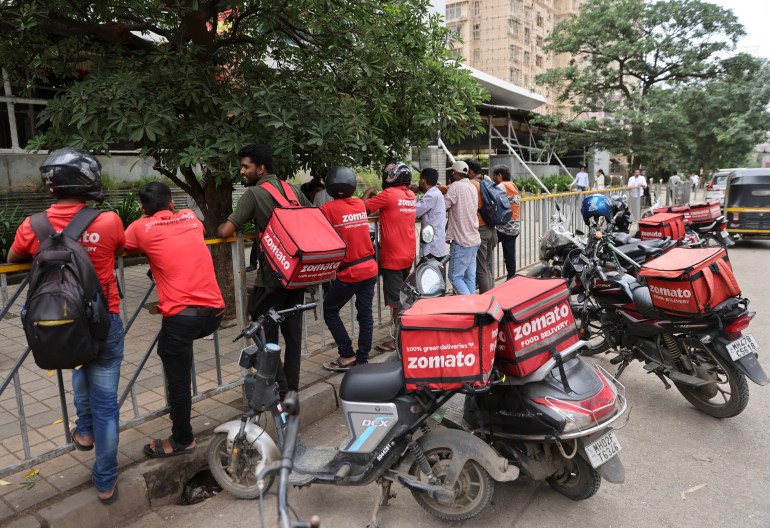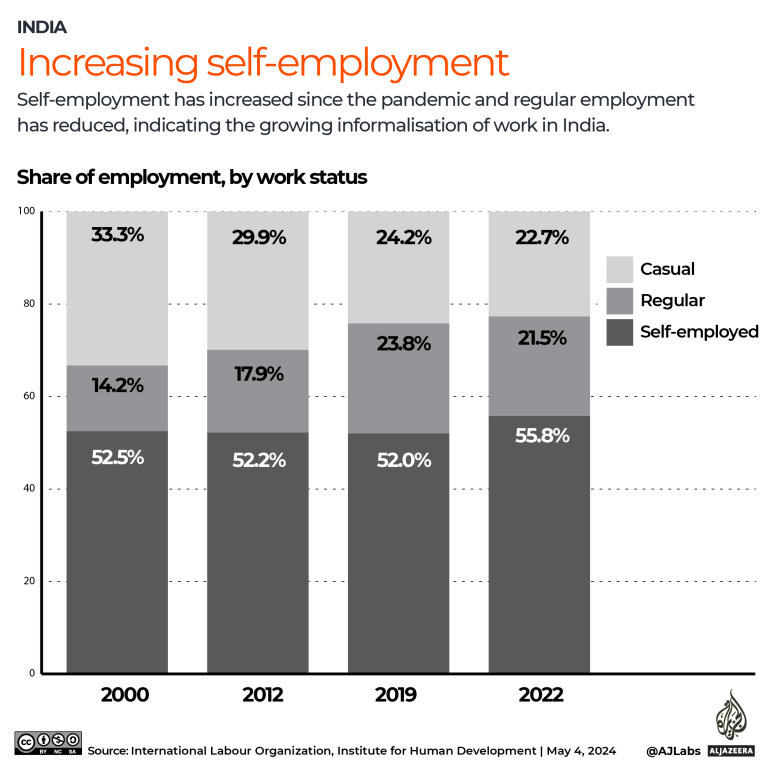He signed up for a job with the food delivery app Zomato, thinking this could be his path to earning money to pay for college fees.
Sahu began with just a few hours of work so he could attend college alongside his job, but he could hardly make enough deliveries on a bicycle or earn much.
He took a loan from friends and a finance company and bought a scooter so he could take on more work. Even as the loan repayments kicked in, Zomato reduced its payment to delivery workers like Sahu, and he got fewer deliveries as more drivers joined the app.
Sahu scaled up his work to as much as 14 hours a day, going to college only to take exams, but he still had to borrow money from his parents for loan repayments.
Frustration mounting, Sahu and other drivers in Ranchi staged a strike asking to be paid better. But, Sahu says, company officials told them they could hire others from India’s growing army of bike riders instead and could block the strikers from the app.
This broke the strike – and left Sahu with loans and his dream of college and a job seeming more distant than before.
Sahu is among a growing number of Indians bearing the brunt of the increasing informalisation of work in India. The India Employment Report 2024, a study released in March by the International Labour Organization (ILO) and the Institute for Human Development, says that India’s workforce is getting more informalised and that the quality of employment has suffered especially in the aftermath of the COVID-19 pandemic.
Sahu’s experience is characteristic not only of India’s growing gig economy, but also seems symptomatic of the broader employment landscape. About 70 percent of India’s construction workers and 62 percent of its casual agricultural workers earn salaries below minimum wage, found the study, which uses government data.
Even in the formal sector, about 18 percent of workers did not have work contracts that could protect them. They also had fewer benefits than before, the study found.
‘Slippage’ in job quality
While India’s economy is pegged to grow at a robust 6.5 percent in the financial year ending March 2025, according to the United Nations Trade and Development, its ability to create quality jobs to meet the aspirations of its increasingly educated youth has emerged as one of the key issues of the national election currently under way.
Jayati Ghosh, a professor of economics at the University of Massachusetts Amherst, wrote in a recent column, “With tens of millions of highly educated young people joining the workforce every year, unmet expectations and growing social unrest threaten to turn the country’s much-anticipated ‘demographic dividend’ into a disaster”.
Not surprisingly, opposition leaders such as Rahul Gandhi have accused the government of “destroying employment”. INDIA bloc, the coalition of opposition parties that Gandhi’s Congress Party is a part of, has announced that it will create a right to apprenticeship that could lead to a job for young people if the coalition is elected.
While recent reports have pegged employment differently, the quality of jobs seems more tenuous than before.
“There has been a slippage in the quality of jobs,” said Amit Basole, head of the Centre for Sustainable Employment at the Azim Premji University in Bengaluru.
Ravi Srivastava, one of the lead authors of the India Employment Report and director of the New Delhi-based Institute for Human Development’s Centre for Employment Studies, said “The share of informal workers in the economy went up.”
Nearly 90 percent of the workforce is informally employed, the report says. Self-employment as a form of work grew 3.8 percentage points between 2019 and 2022, while regular employment declined to 21.5 percent from 23.8 percent. The share of casual employment declined to 22.7 percent in 2022 from 24.2 percent in 2019.
Basole noted, “We see a shift since the 2000s, with a destruction of jobs at the lower end.”
This trend seems to have accentuated sharply after 2019, when the pandemic hit, and millions were pushed into more insecure employment as the country went into a sudden lockdown overnight and businesses big and small shut, with many of the latter never recovering from that shock.
With workers back in their villages, agriculture saw an increase in workers of nearly 56 million from 2020 to 2022, reversing a slow trend of workers moving from agriculture into more value-added service sector jobs, the report said.
Women also increasingly entered the workforce during this period, but a little more than half of them did unpaid work in agriculture, usually on family farms, Srivastava said, adding that it is a trend that has continued.
“The data shows the precarity of women’s work. The degree of informality for women workers is higher than for men,” he said.
Precariousness of the gig economy
Work for both men and women may have remained precarious even after the pandemic as men often returned to big cities for jobs in construction or in the gig economy, both areas with little security.

The Indian government has objected to the ILO report and its employment estimates, adding that the growing gig sector was not well accounted for in the report.
India’s government think-tank, NITI Aayog, estimated that 7.7 million people worked in such jobs in 2020-2021. It expects more than 23.5 million workers could be employed in gig work by 2029-2030.
Srivastava says that while it is hard to estimate the number of gig workers, the total has only gone up since the pandemic.
In cities, too – as not all shops, restaurants and salons had reopened – women were forced to take up gig work.
In May 2022, Mumbai beautician Gurpreet Sharma’s two fingers got stuck together while fixing nail extensions for a client. Unsticking them with oil had led to swelling and burns on her fingers, limiting her ability to work or do household chores for months. Urban Company, a platform offering at-home services through which she got the job, did not provide her medical insurance since it covered only hospitalisation.
Months later, with her husband’s work as an assistant dance choreographer in Bollywood getting more irregular, Sharma once again restarted work with Urban Company. A client’s dogs bit her while she was at a home pedicure appointment. She had pressed the app’s emergency button, but to no avail. The client paid for Sharma’s anti-rabies shots after she filed a police complaint. Another time, a friend accepted on the Urban Company app a job of doing a facial for a man. But she fled that client’s house unpaid because of sexual advances he made.
Like Sahu, Sharma and her Urban Company colleagues have spent the last two years trying to form a union. They asked to be called employees rather than partners and get benefits accordingly, but to no avail.
Pratik Mishra, of the All India Gig Workers Union, which had helped Sahu in organising efforts, said he had worked with unions in Ranchi’s large coal and steel sector for years, but what he encountered with delivery workers was like nothing he had seen before.
“They were so replaceable, the company did not even consider them to be workers and they could get blocked by an algorithm anytime. They were so vulnerable.”
After his fiasco with unionising, Sahu looked for other means to fund his studies and joined a loan collection agency where his job was to make calls to chase outstanding dues along with occasional food deliveries.

Now 22, he has also enrolled for a master’s degree in computer applications, along with preparing for several of India’s competitive exams for coveted, and stable, federal government jobs.
He can hardly afford to attend college due to work commitments, and he studies through free tutorials on YouTube.
He is downbeat about his job prospects. More than 400,000 applicants take the exams for less than 12,000 government jobs. “Kya chance hai?” he asks rhetorically. “What are my chances?”
Then he answers himself: “0.001 percent”.
Chance for betterment
Tapping into this aspiration for government jobs, Tejashwi Yadav, the opposition leader from Sahu’s neighbouring state of Bihar, has announced that the opposition INDIA bloc will provide 10 million jobs, partly by filling open government positions.
For now, Sahu worries he is not developing the skills he needs through the practical training that the college provides, but the need to earn money has limited his choices. “Hum to saari taraf se phas rahe hain [We are trapped all around],” he said, referring to his job prospects.
Alexandra Hermann, lead economist in London at Oxford Economics, said a major “impediment [to creating quality jobs] has been human capital levels”.
Just as Sahu worries about the skills he’s acquiring, surveys have shown that learning levels have been low in Indian schools and colleges although enrolment is up.
Government spending on infrastructure development has led to the creation of construction jobs rather than the service sector jobs that India’s increasingly educated youth such as Sahu aspire to, Hermann pointed out, adding, that those are “not necessarily the kind of jobs we want”. It is time for the government to spend on improving educational levels and creating service sector jobs, she said.
The Indian employment report also found that when students do get a higher education, it leads to better employment.
Lal Singh, a 24-year-old from Mumbai, earned enough money from food delivery jobs to pay for courses that enabled him to become an app developer, the job he dreamed of.
Growing up, Singh’s father had sold magazines at Mumbai’s busy traffic signals, and the family lived in a packed slum in the city’s southern tip. But Singh had grown up playing video games and idolising Tesla and SpaceX CEO Elon Musk.
While in college, he had joined a skills training course by the non-profit Antarang and found a job with a software company. While there, he continued doing courses to upgrade his skills. He now develops apps for United States companies, but is finding it hard to move to a better role in the currently tight job market.
But Singh’s success is not easy to replicate. While more Indians are getting a college education than before – and the enrollment for women in science degrees is among the highest in the world, according to Finance Minister Nirmala Sitharaman – more than 83 percent of India’s unemployed are among the youth, the ILO report says.
Sahu’s exam for a government job is in July, but juggling between loan collection work, deliveries, college and test preparation means he constantly feels he is failing somewhere, and the prospect of landing a good job is only getting more difficult. When things get hard, Singh occasionally turns back to food delivery.
